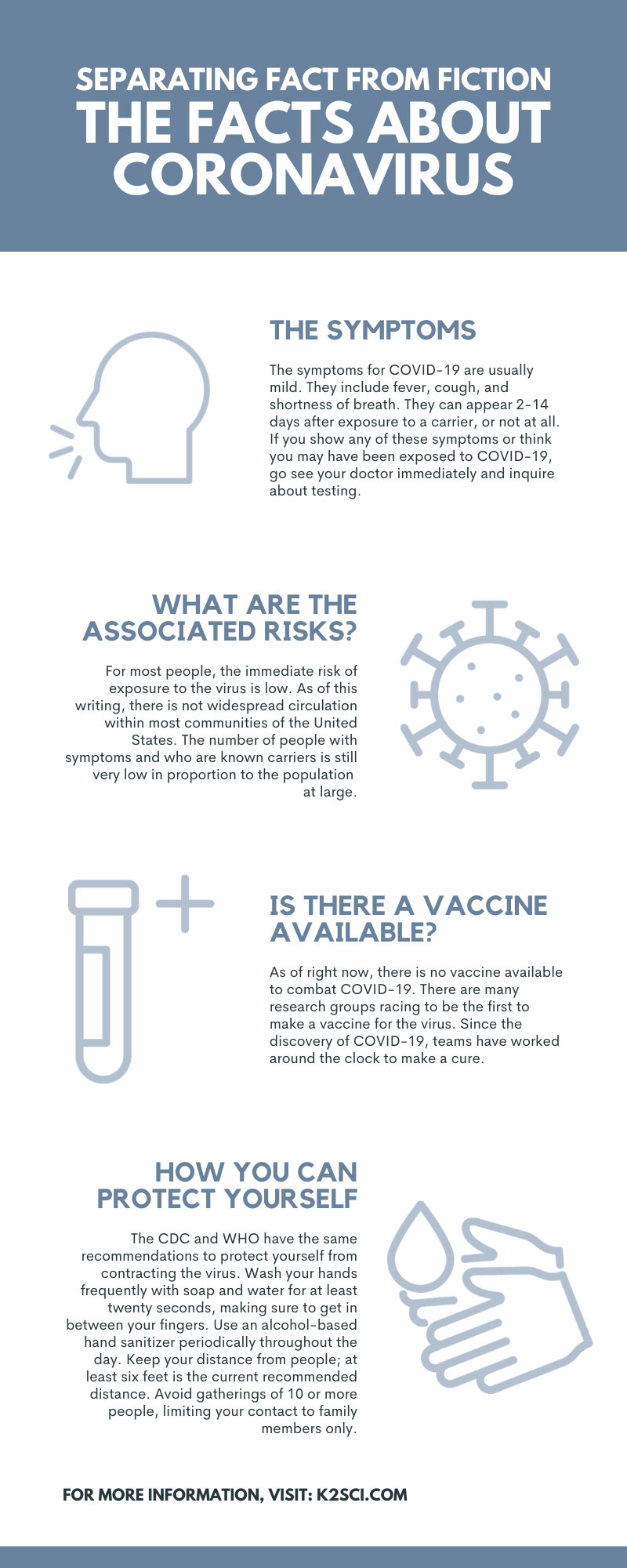There is a lot of misinformation spreading about the COVID-19/coronavirus, and panic has spread around the world. The whole of Italy is on lockdown, and people aren’t allowed to leave their homes. New York State has set up a coronavirus containment area around New Rochelle using the National Guard. Dozens of conferences and gatherings like the SXSW Festival in Austin, Texas, have been cancelled. The NCAA Men’s and Women’s tournaments will be played in front of no one. The NBA has suspended the remainder of its season. And the examples go on and on. Fear and panic have taken hold, and reactions are swift. Here are the facts about coronavirus for your consideration. Read them and be informed.
The History of Coronaviruses
The coronavirus name comes from the Latin word for crown, “corona.” The virus has a crown-like shape and appearance with bulbous protrusions that also resemble the coronas of a star. It was named in the 1960s when a strain was first discovered in chickens that had an infectious bronchitis virus. Coronaviruses are part of a large family of viruses that are very common in people and different species of animals, including bats, camels, cats, and cattle. It is rare that an animal coronavirus can infect people and then spread among them. Prior to the COVID-19, there were only two other instances of a coronavirus happening: the MERS outbreak in 2012, and the SARS outbreak of 2003. Coronaviruses can cause diarrhea in cows and pigs and upper respiratory illnesses in chickens. In humans, the viruses are spread via airborne drops of fluid from an infected person. Since coronaviruses’ discovery, health officials closely monitor them. A novel (new) coronavirus previously called 2019-nCoV is now known as COVID-19. The first patients to contract the virus had a link to a seafood market in Wuhan, Hubei Province, China, and that fact indicated an animal-to-human passage. More patients emerged over time with no tie to the market, indicating a human-to-human (or community) transfer. It’s not currently known what animal passed the virus on to patient zero, but it’s believed to be a bat.
The Symptoms
The symptoms for COVID-19 are usually mild. They include fever, cough, and shortness of breath. They can appear 2-14 days after exposure to a carrier, or not at all. If you show any of these symptoms or think you may have been exposed to COVID-19, go see your doctor immediately and inquire about testing. While most patients recover, other patients have died from exposure to COVID-19, so if you have been in close contact with someone that has it, please see your doctor.
What Are the Associated Risks?
For most people, the immediate risk of exposure to the virus is low. As of this writing, there is not widespread circulation within most communities of the United States. The number of people with symptoms and who are known carriers is still very low in proportion to the population at large. People who are in places where ongoing community spread has been reported are at an elevated risk of exposure. People who have spent time overseas in the previous months are at an increased risk as well. Health professionals who are caring for those with the virus are at an elevated risk too.
The CDC Response
The CDC is focusing its efforts on lessening the spread of the virus. The federal government is working closely with state and local officials to respond to the public health threat. The CDC activated its emergency operations center to provide continuing support to local officials in the fight against the spread. The US government started with a ban that prohibited anyone from entering the US from China or Iran, or who had been in either of those countries within the previous 14 days. The travel ban increased on March 11 when all flights originating in Europe were not allowed to land in the US for a period of 30 days. That meant no person from any country in Europe would be allowed to travel to the US. Commercial flights that are carrying cargo will still be permitted.
What the WHO Says
The World Health Organization has declared that the COVID-19 virus is now a pandemic. A pandemic is an occurrence when a disease spreads quickly and affects a large number of people over a wide area. The director general of the WHO, Tedros Adhanom Ghebreyesus, in his briefing on March 12, 2020, expressed his concern at the speed in which the virus was spreading and gave his reasons for proclaiming a pandemic.
He said, “Almost 125,000 cases have now been reported to WHO, from 118 countries and territories. In the past two weeks, the number of cases reported outside China has increased almost thirteen-fold, and the number of affected countries has almost tripled… [W]e are deeply concerned that some countries are not approaching this threat with the level of political commitment needed to control it. Let me be clear: describing this as a pandemic does not mean that countries should give up…This is a controllable pandemic. Countries that decide to give up on fundamental public health measures may end up with a larger problem and a heavier burden on the health system that requires more severe measures to control.”
Is There a Vaccine Available?
As of right now, there is no vaccine available to combat COVID-19. There are many research groups racing to be the first to make a vaccine for the virus. Since the discovery of COVID-19, teams have worked around the clock to make a cure. They are testing other vaccines that might help in the fight while trying to create a new one. Vaccines don’t appear as fast as the disease. There are months of testing on animals involved before scientists can conduct human trials. Once vaccines are available, manufacturers will distribute them to clinics and hospitals. Proper transportation and storage of them in medical fridges will be important to preserving them and keeping them effective until they are administered to the general public.
How You Can Protect Yourself
The CDC and WHO have the same recommendations to protect yourself from contracting the virus. Wash your hands frequently with soap and water for at least twenty seconds, making sure to get in between your fingers. Use an alcohol-based hand sanitizer periodically throughout the day. Keep your distance from people; at least six feet is the current recommended distance. Avoid gatherings of 10 or more people, limiting your contact to family members only.

